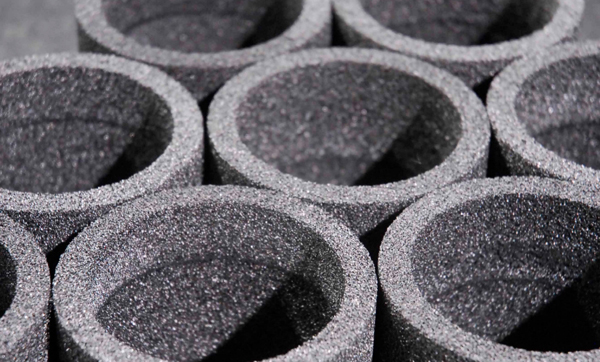
Electrically Calcined Anthracite, or ECA for short, is coal with an excellent CO2 absorption capacity and unique structural characteristics. It has high helical pore percentages and contains a fine-grained component that's amorphous. This makes ECA an ideal candidate for use in a wide variety of energy and environmental applications, including but not limited to, fuel cells, carbon nanofibers, and other gas diffusion electrodes.
ECA foams have better performance than natural graphite or mesophase, as well as other carbon foams. ECA foams are known for their superior mechanical properties, which is due to the large surface and unique cell microstructure. Carbon foams made from ECA do not degrade or exfoliate over time, like natural graphite microbeads and mesophase.

The highly ordered structure of ECA and its removal of contaminants such as sulfur and hydrogen that may interact with the electrolyte and metal ions to cause unwanted half-cell reaction are responsible for the increased electrical conductivity.
The cellular material needs to be properly graphitized and calcined in order to create a foam of carbon suitable for fuel cell electrodes. During the production process, a coal particulate of a preferably small size is heated to high temperatures, thereby converting the amorphous carbon to a crystalline carbon and producing a calcined carbon foam. The calcined foam needs to be purified further by activation and graphitization in order to obtain high performance carbon foam.
To achieve this, the carbonized foam is heated in an atmosphere of inert gas to temperatures ranging from 800degC to 1200degC. This heat increases the specific surface area while improving the distribution of pore sizes, homogenizing the structure, and preventing cracking. To achieve these goals, the carbon foam is heated to a temperature range of 800degC to 1200degC in an inert atmosphere, whereby the amorphous carbon in the reticulate network is converted to a more dense crystalline structure that can be further refined and graphitized for optimal performance as an electrode material.
One alternative way to make a carbon foam that is suitable for fuel-cell electrodes is directly carbonizing MS, without any additions. The resulting foam shows high porosity with excellent elasticity.
Chen et.al.92 devised a new technique for direct carbonization. They cut a MF sponge into a solid block and then immersed it in a solution containing 3 mg/L of grapheneoxide for a period of time. Finally, they sonicated the block to create a suspension. This slurry is then spun-coated on the amorphous graphite and dried for four hours at 60degC to form a porous SC electrode composite of carbon/graphene (CF-GO). The graphene oxide/carbonized foam composite exhibited a very high capacity performance. This demonstrates that proper synthesis and purification are important in the preparation carbon foams to be used as fuel cells electrodes.

Write a Message